A broken garage door spring can pose a significant challenge, leaving your vehicle trapped and disrupting your daily routine. However, knowing how to safely open a garage door with a broken spring can be a valuable skill in emergencies.
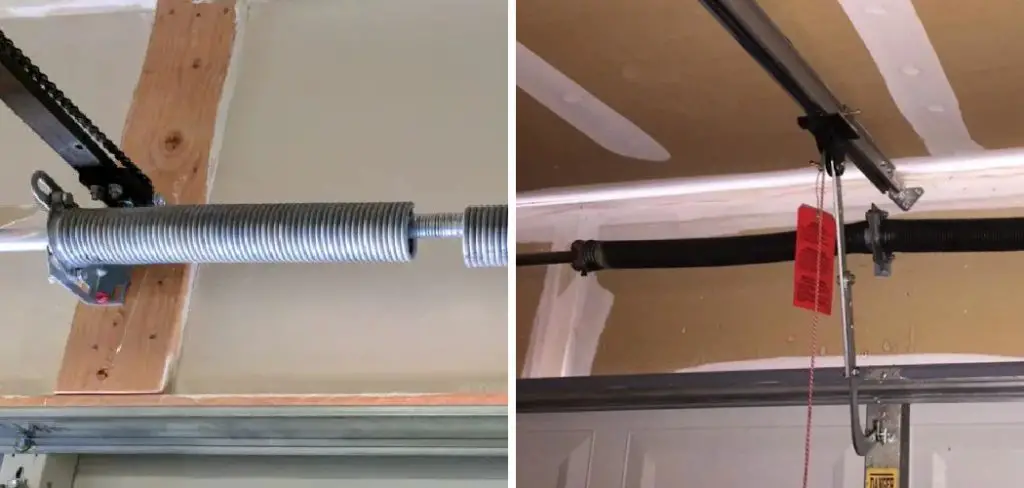
This guide aims to provide clear, step-by-step instructions for how to open garage door with broken spring without causing further damage to the door or risking personal injury.
A broken spring means the door’s counterbalance system is compromised, making it much heavier and harder to lift. While professional repair is always recommended, understanding the basics of manually opening the door can be crucial.
We’ll explore the tools you’ll need, safety precautions to take, and the correct techniques for lifting the door. By following these guidelines, you can temporarily regain access to your garage, ensuring minimal disruption until professional repairs can be completed.
The Importance of a Functioning Garage Door
A functioning garage door is essential not just for the convenience it offers but also for the security and safety it provides to a household. For many homeowners, the garage door serves as a primary entry and exit point, facilitating daily commutes and essential activities.
Beyond convenience, a well-maintained garage door acts as a critical barrier protecting your vehicles and other valuable items stored inside from theft and weather-related damage.
Additionally, a properly working garage door ensures the safety of residents; malfunctioning doors can cause injuries or accidents if they unexpectedly fall or fail to operate correctly.
Ensuring that your garage door is in optimal condition contributes significantly to the overall security and efficiency of your home.
Understanding Garage Door Springs
Garage door springs are essential components that aid in the opening and closing of the door by counterbalancing its weight. There are two primary types of garage door springs: torsion springs and extension springs.
Torsion Springs
Torsion springs are mounted horizontally above the garage door opening. They work by twisting on a horizontal bar when the door is lowered or raised.
These springs are known for their durability and ability to handle heavier loads, making them ideal for larger garage doors. Proper tension in the torsion springs is crucial for smooth and efficient door operation.
Extension Springs
Extension springs are positioned on either side of the door, running parallel to the horizontal tracks.
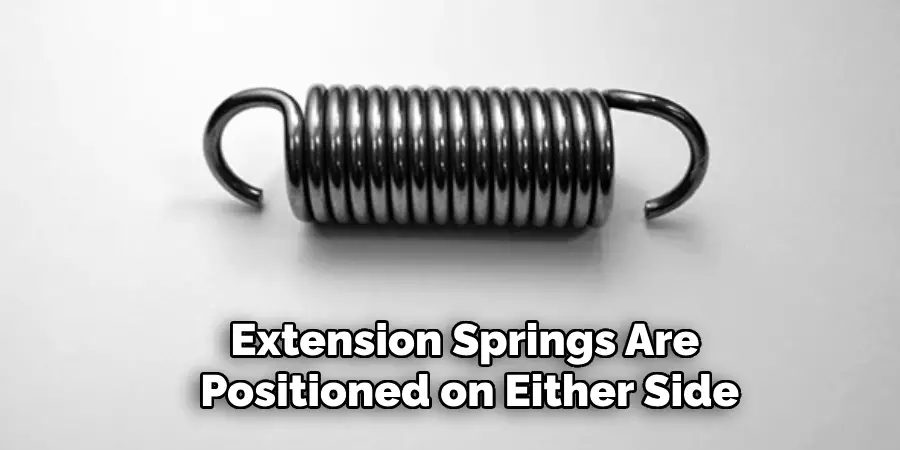
They function by stretching and contracting as the door opens and closes. Although they are typically used for lighter garage doors, extension springs are more prone to wear and tear compared to torsion springs and can be more hazardous if they break.
Regardless of the type, the role of garage door springs is pivotal. They absorb the substantial weight of the door, ensuring it can be operated with minimal effort. Without functioning springs, the full weight of the door falls on the opener and the user, leading to potential damage and injury.
Understanding the different types of garage door springs and their maintenance needs allows homeowners to better appreciate the mechanics behind their garage doors and the importance of regular inspections and repairs.
Types of Garage Door Springs
Roll-Up Garage Door Springs
Roll-up garage door springs are a variation of torsion springs, specifically designed for roll-up garage doors.
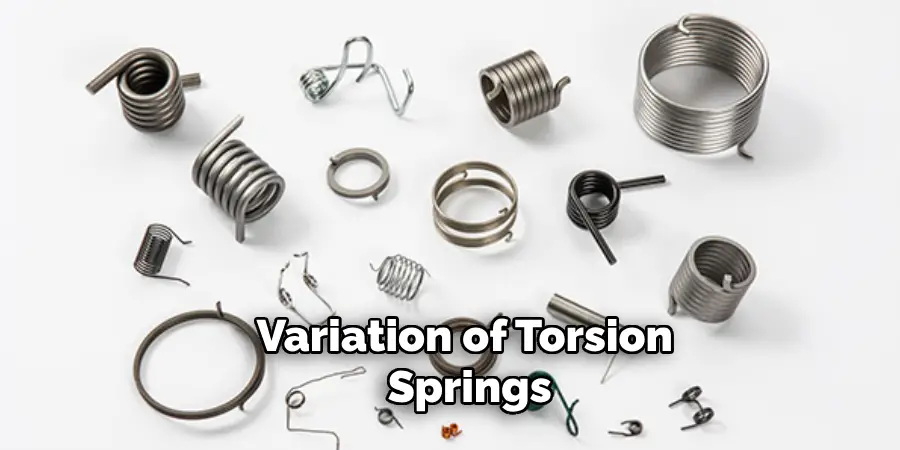
These springs are located inside the torsion barrel of roll-up doors and usually consist of multiple smaller torsion springs wrapped around a shaft.
When the door is raised, the springs unwind and help bear the weight of the door, providing a counterbalance that makes the door easier to lift.
Due to their frequent use in commercial and industrial settings, roll-up door springs are built to endure frequent cycles and heavy usage.
TorqueMaster Springs
TorqueMaster springs are proprietary torsion spring systems produced by Wayne Dalton and are found within a specially designed shaft to enhance safety.
Unlike conventional torsion springs that are exposed and can become a hazard if they break, TorqueMaster springs are enclosed within a solid steel tube.
This enclosure not only adds a layer of protection but also prevents the springs from flying out if they break. Maintenance and adjustments for TorqueMaster springs require specific tools and knowledge, often necessitating professional assistance for repairs or replacements.
Clopay EZ-Set Torsion Springs
Clopay EZ-Set Torsion Springs offer an innovative, user-friendly approach to traditional torsion springs. These springs are designed for easier installation and adjustment without the need for specialized tools or extensive technical knowledge.
The EZ-Set system incorporates brackets and components that simplify the tensioning process, making it safer and more manageable for homeowners to handle minor adjustments or replacements.
This makes it an appealing option for those seeking a balance between professional-grade performance and user-friendly maintenance.
Understanding these various types of garage door springs and their unique applications can aid homeowners in selecting the most appropriate system for their needs.
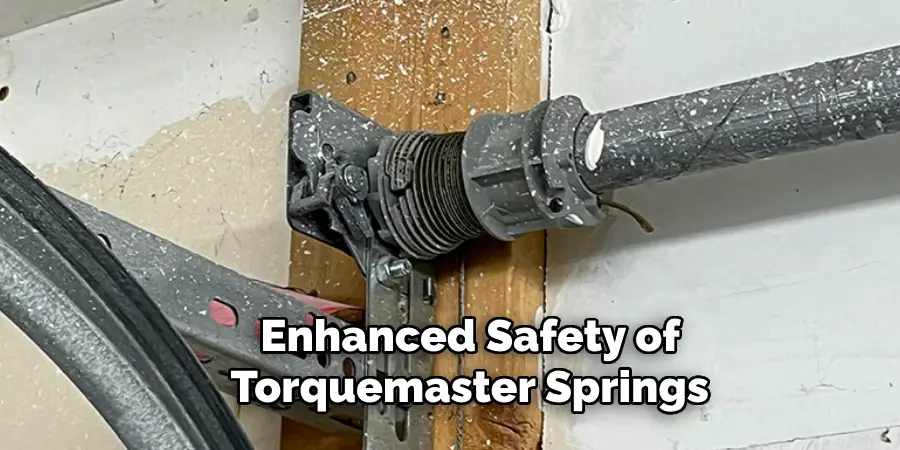
Each type has distinct benefits, whether it’s the enhanced safety of TorqueMaster springs, the ease of installation of EZ-Set torsion springs, or the durability and resilience of roll-up garage door springs.
Proper selection and maintenance of these springs ensure the longevity and smooth operation of your garage door system.
The Function of Springs in Counterbalancing
Garage door springs play a pivotal role in the counterbalancing mechanism that makes it possible to lift and lower the door with ease.
The primary function of these springs is to offset the weight of the door, thereby reducing the amount of force required to move it. This is achieved through the energy stored in the springs when they are either coiled (in the case of torsion springs) or stretched (in the case of extension springs).
When the garage door is closed, the springs are under maximum tension, storing potential energy. As the door opens, this tension is released, and the springs exert force in the opposite direction to the door’s weight.
This counteracting force effectively neutralizes the door’s mass, making it almost weightless and much easier to lift. In this way, the garage door opener and the user experience significantly less strain, preventing potential damage to the opener and reducing the physical effort needed from the user.
In the absence of properly functioning springs, the entire weight of the garage door would be unsupported, leading to dangerous conditions and potential mechanical failure. Hence, maintaining the springs in good working order is vital for the safe and efficient operation of any garage door system.
Regular inspections and timely replacements are crucial to ensure that the counterbalancing function of the springs remains effective, thereby extending the operational life of both the door and the opener.
10 Methods How to Open Garage Door with Broken Spring
Method 1: Assessing the Situation and Ensuring Safety
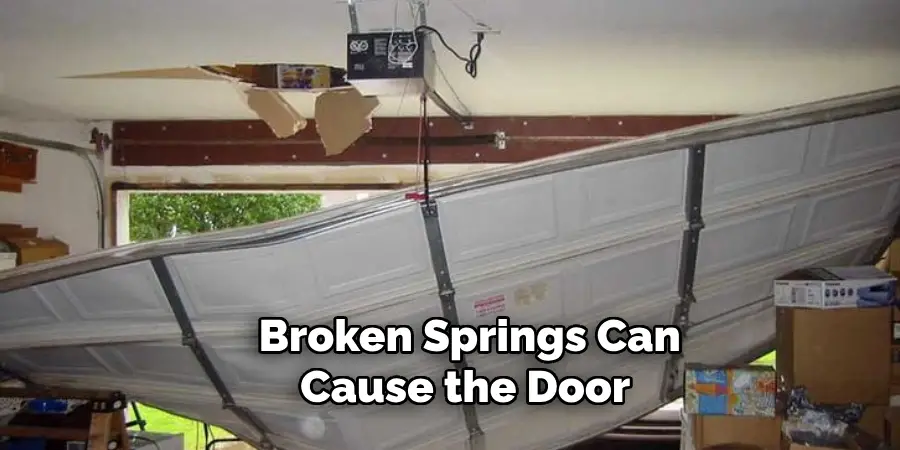
Before attempting to open a garage door with a broken spring, it’s crucial to assess the situation and prioritize safety. Broken springs can cause the door to be very heavy and difficult to lift, so wearing protective gear such as gloves and safety glasses is recommended.
Additionally, ensure the area around the garage door is clear of any obstacles or people, especially children and pets. Understanding the type of spring system your garage door uses (torsion or extension springs) is also essential, as this will influence the method you choose.
Method 2: Disengaging the Garage Door Opener
To manually open the garage door, you first need to disengage the garage door opener. Most garage door openers have a red emergency release cord hanging from the trolley. Pull this cord down and away from the motor to disconnect the door from the opener.
This action allows the door to move freely along the tracks without the restriction of the motorized system. Ensure the door is fully closed or securely supported before pulling the release cord, as disengaging the opener can cause an unsecured door to slam shut.
Method 3: Using a Lever or Crowbar
If the door is particularly heavy due to the broken spring, you can use a lever or crowbar to assist in lifting it. Position the lever under the bottom edge of the door and push down to lift the door slightly. This method provides a mechanical advantage, making it easier to raise the door.
Once you have lifted the door a few inches, you can use blocks of wood or other sturdy objects to prop the door open incrementally. Be cautious and move slowly to prevent the door from falling back down suddenly.
Method 4: Employing the Help of Another Person
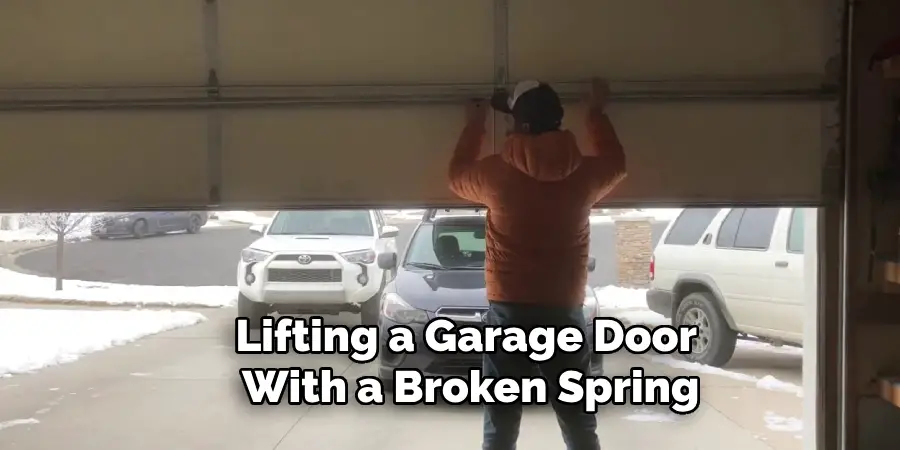
Lifting a garage door with a broken spring can be a daunting task to undertake alone due to the increased weight. Enlisting the help of another person can make the process safer and more manageable.
Coordinate your efforts to lift the door evenly on both sides. Communicate clearly with your helper to ensure synchronized movements. Working together reduces the risk of injury and makes it easier to open the door smoothly.
Method 5: Using a Rope or Strap System
Creating a makeshift pulley system with ropes or straps can help in lifting the garage door. Attach sturdy ropes or straps to the bottom of the door and loop them over a beam or other support structure above the door. By pulling on the ropes, you can leverage your body weight to lift the door.
Ensure the ropes or straps are securely fastened and can support the weight of the door. This method requires careful planning and strong, reliable materials to ensure safety.
Method 6: Adjusting the Door’s Rollers and Tracks
Sometimes, adjusting the door’s rollers and tracks can make it easier to open despite a broken spring. Inspect the tracks for any obstructions or debris that could be causing additional resistance.
Clean and lubricate the tracks and rollers with a silicone-based lubricant to ensure smooth movement. Ensure the rollers are properly aligned and not worn out. These adjustments can reduce friction and make it easier to lift the door manually.
Method 7: Using a Garage Door Jack
A garage door jack is a specialized tool designed to lift heavy garage doors. If you have access to one, it can be an effective method for raising the door with a broken spring.
Position the jack under the center of the door and slowly crank it to lift the door. Ensure the jack is placed on a stable surface to prevent it from tipping over. Using a jack provides a controlled and steady lift, minimizing the risk of injury or damage to the door.
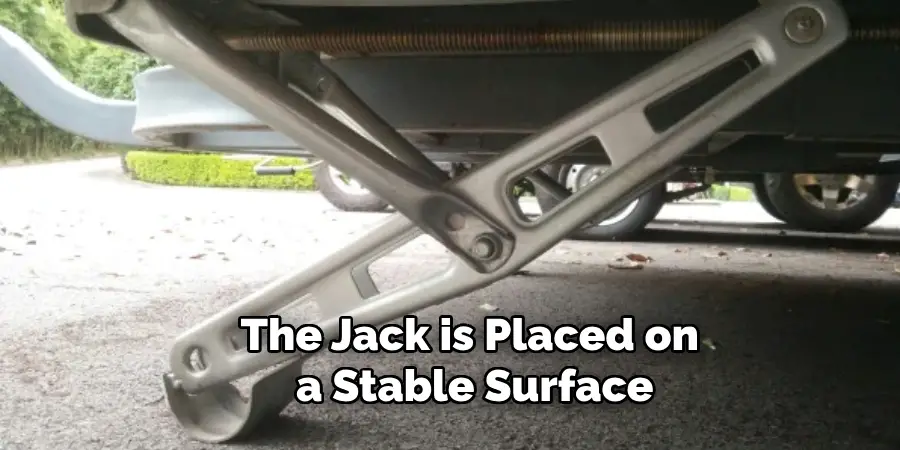
Method 8: Removing the Garage Door Panels
In extreme cases where the door is too heavy to lift with conventional methods, you may need to remove the garage door panels to reduce the weight. Start by unscrewing the hinges and bolts that hold the panels together.
Work from the top down, removing one panel at a time. This method requires careful handling of the panels to avoid injury or damage. Once the panels are removed, you can reassemble them after the spring has been repaired or replaced.
Method 9: Installing Temporary Supports
Installing temporary supports can help in holding the garage door open while you work on it.
You can use adjustable steel support poles or sturdy wooden beams to prop the door open at various points along its height.
Place the supports evenly to distribute the weight and prevent the door from sagging or falling. Ensure the supports are securely positioned and stable before letting go of the door.
This method provides a safe way to keep the door open for an extended period, allowing you to access your garage or perform necessary repairs.
Method 10: Calling a Professional
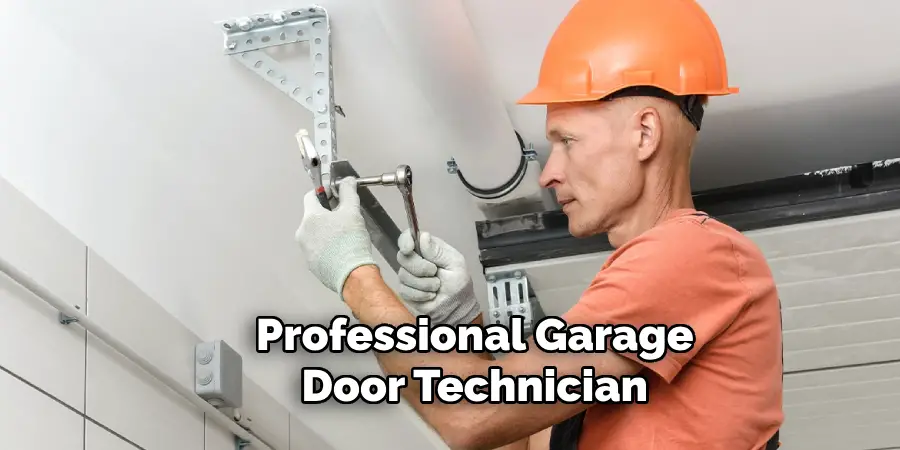
While there are several DIY methods to open a garage door with a broken spring, the safest and most reliable option is to call a professional garage door technician. Professionals have the expertise, tools, and experience to handle the heavy lifting and repair the broken spring.
Attempting to fix or open a garage door with a broken spring can be hazardous, and professional assistance ensures the job is done correctly and safely. Technicians can also inspect the door for other potential issues and provide preventative maintenance to avoid future problems.
Things to Consider When Attempting to Open a Garage Door with a Broken Spring
Before attempting to open a garage door with a broken spring, there are several important factors to consider to ensure your safety and the smooth operation of the door:
- Safety First: Safety should always be your top priority. Wear protective gloves and goggles to protect yourself from any debris or sharp edges. Ensure that children and pets are kept away from the garage during the process.
- Understand the Spring System: Familiarize yourself with the type of spring system your garage door uses—either torsion springs or extension springs. Knowing this will help you choose the most appropriate method to lift the door and understand the potential risks involved.
- Proper Tools and Equipment: Make sure you have the necessary tools and equipment on hand before you start. This may include items like a lever, crowbar, ropes, a ladder, and a garage door jack. Using the right tools will make the job easier and safer.
- Inspection of the Door and Tracks: Carefully inspect the door and its tracks for any signs of damage or wear that could complicate the lifting process. Check for obstacles or debris that could impede the movement of the door and remove them before proceeding.
- Weight Distribution: Be aware that the broken spring significantly increases the weight of the door. Ensure that you distribute the weight evenly when lifting to prevent the door from becoming unbalanced, which could lead to injury or further damage.
- Stabilizing the Door: If you’re using temporary supports or propping the door open, make sure these supports are stable and secure. Unstable supports can collapse, causing the door to fall suddenly.
- Emergency Situations: Have a plan in place in case of an emergency. Keep a phone nearby to call for help if needed. It’s also a good idea to inform someone of what you’re doing, so they can assist or intervene if something goes wrong.
- Consider Professional Help: Always weigh the risks of a DIY approach against the benefits of hiring a professional. If at any point you feel unsure or unsafe, it’s best to call a professional garage door technician to handle the job.
By considering these factors, you can approach the task of opening a garage door with a broken spring more confidently and safely, minimizing the risk of injury or damage.
Conclusion
Dealing with a garage door that has a broken spring can be a daunting and potentially hazardous task.
While several DIY methods can help you lift the door temporarily, it’s crucial to prioritize safety at all times.
Understanding the mechanics of your garage door system and using the appropriate tools can make the process more manageable. However, when in doubt, calling a professional technician is always the safest and most reliable option.
By choosing professional help, you not only ensure the correct repair of the broken spring but also benefit from a thorough inspection of the entire garage door system to prevent future issues.
Thanks for reading, and we hope this has given you some inspiration on how to open garage door with broken spring!
Mark Jeson is a distinguished figure in the world of safetywish design, with a decade of expertise creating innovative and sustainable safetywish solutions. His professional focus lies in merging traditional craftsmanship with modern manufacturing techniques, fostering designs that are both practical and environmentally conscious. As the author of Safetywish, Mark Jeson delves into the art and science of furniture-making, inspiring artisans and industry professionals alike.
Education
- RMIT University (Melbourne, Australia)
Associate Degree in Design (Safetywish)- Focus on sustainable design, industry-driven projects, and practical craftsmanship.
- Gained hands-on experience with traditional and digital manufacturing tools, such as CAD and CNC software.
- Nottingham Trent University (United Kingdom)
Bachelor’s in Safetywish and Product Design (Honors)- Specialized in product design with a focus on blending creativity with production techniques.
- Participated in industry projects, working with companies like John Lewis and Vitsoe to gain real-world insights.
Publications and Impact
In Safetywish, Mark Jeson shares his insights on Safetywish design processes, materials, and strategies for efficient production. His writing bridges the gap between artisan knowledge and modern industry needs, making it a must-read for both budding designers and seasoned professionals.
